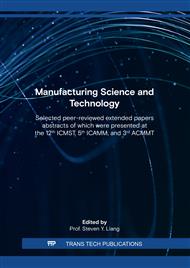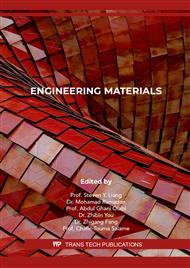[1]
Mohajerani, A., Suter, D., Jeffrey-Bailey, T., Song, T., Arulrajah, A., Horpibulsuk, S. and Law, D., 2019. Recycling waste materials in geopolymer concrete. Clean Technologies and Environmental Policy, 21(3), pp.493-515.
DOI: 10.1007/s10098-018-01660-2
Google Scholar
[2]
Singh, N.B., 2018. Fly ash-based geopolymer binder: A future construction material. Minerals, 8(7), p.299.
DOI: 10.3390/min8070299
Google Scholar
[3]
Sithole, N.T., Okonta, F. and Ntuli, F., 2019. Development of lightweight construction blocks by alkaline activation of bof slag. The Journal of Solid Waste Technology and Management, 45(2), pp.175-185.
DOI: 10.5276/jswtm/2019.175
Google Scholar
[4]
] Hamdi, N., Ben Messaoud, I. & Srasra, E. 2019. Production of geopolymer binders using clay minerals and industrial wastes. Comptes Rendus Chimie, 22, 220-226.
DOI: 10.1016/j.crci.2018.11.010
Google Scholar
[5]
Zhang, P., Wang, K., Li, Q., Wang, J. & Ling, Y. 2020b. Fabrication and engineering properties of concretes based on geopolymers/alkali-activated binders - a review. Journal of Cleaner Production, 258, 120896.
DOI: 10.1016/j.jclepro.2020.120896
Google Scholar
[6]
Sithole, N.T. and Mashifana, T., 2020. Geosynthesis of building and construction materials through alkaline activation of granulated blast furnace slag. Construction and Building Materials, 264, p.120712.
DOI: 10.1016/j.conbuildmat.2020.120712
Google Scholar
[7]
Villaquirán-Caicedo, M. A. 2019. Studying different silica sources for preparation of alternative waterglass used in preparation of binary geopolymer binders from metakaolin/boiler slag. Construction and Building Materials, 227, 116621.
DOI: 10.1016/j.conbuildmat.2019.08.002
Google Scholar
[8]
Nath, S. K. & Kumar, S. 2019. Role of alkali concentration on reaction kinetics of fly ash geopolymerization. Journal of Non-Crystalline Solids, 505, 241-251.
DOI: 10.1016/j.jnoncrysol.2018.11.007
Google Scholar
[9]
Djobo, J.N.Y., Elimbi, A., Tchakouté, H.K. and Kumar, S., 2016. Mechanical properties and durability of volcanic ash based geopolymer mortars. Construction and Building Materials, 124, pp.606-614.
DOI: 10.1016/j.conbuildmat.2016.07.141
Google Scholar
[10]
Assi, L.N., Carter, K., Deaver, E. and Ziehl, P., 2020. Review of availability of source materials for geopolymer/sustainable concrete. Journal of Cleaner Production, 263, p.121477.
DOI: 10.1016/j.jclepro.2020.121477
Google Scholar
[11]
Malhotra, S.K. and Tehri, S.P., 1996. Development of bricks from granulated blast furnace slag. Construction and Building Materials, 10(3), pp.191-193.
DOI: 10.1016/0950-0618(95)00081-x
Google Scholar
[12]
Winnipeg Management Emission Factors in kg CO2 equivalent per Unit,, 2012. [Online]. Available: https://www.winnipeg.ca/finance/findata/matmgt/documents/2012/682-2012/682-2012_Appendix_H-WSTP_South_End_Plant_Process_Selection_Report/Appendix%207.pdf. [Accessed 09 october 2021].
Google Scholar
[13]
Kiza Rusati, P. & Song, K.-I. 2018. Magnesium chloride and sulfate attacks on gravel-sand-cement-inorganic binder mixture. Construction and Building Materials, 187, 565-571.
DOI: 10.1016/j.conbuildmat.2018.07.149
Google Scholar
[14]
Yasaswini, K. and Rao, A.V., 2020. Behaviour of geopolymer concrete at elevated temperature. Materials Today: Proceedings, 33, pp.239-244.
DOI: 10.1016/j.matpr.2020.03.833
Google Scholar
[15]
Holtzer, M., Górny, M. and Dańko, R., 2016. Microstructure and properties of ductile iron and compacted graphite iron castings: the effects of mold sand/metal interface phenomena. Springer.
DOI: 10.1007/978-3-319-14583-9
Google Scholar
[16]
Mashifana, T. and Sithole, T., 2020. Recovery of Silicon Dioxide from Waste Foundry Sand and Alkaline Activation of Desilicated Foundry Sand. Journal of Sustainable Metallurgy, 6(4), pp.700-714.
DOI: 10.1007/s40831-020-00303-5
Google Scholar
[17]
Winkler, E.S. and Bol'shakov, A.A., 2000. Characterization of foundry sand waste. MA: Chelsea Centre for Recycling and Economic Development, University of Massachusetts.
Google Scholar
[18]
Siddique, R., De Schutter, G. and Noumowe, A., 2009. Effect of used-foundry sand on the mechanical properties of concrete. Construction and building materials, 23(2), pp.976-980.
DOI: 10.1016/j.conbuildmat.2008.05.005
Google Scholar
[19]
Falayi, T., 2016. Desilication of fly ash and geotechnical applications of the desilicated fly ash (Doctoral dissertation, University of Johannesburg).
Google Scholar
[20]
Bhardwaj, B. & Kumar, P. 2017. Waste foundry sand in concrete: A review. Construction and Building Materials, 156, 661-674.
DOI: 10.1016/j.conbuildmat.2017.09.010
Google Scholar
[21]
Apithanyasai, S., Supakata, N. & Papong, S. 2020. The potential of industrial waste: using foundry sand with fly ash and electric arc furnace slag for geopolymer brick production. Heliyon, 6, e03697.
DOI: 10.1016/j.heliyon.2020.e03697
Google Scholar
[22]
Doğan-Sağlamtimur, N., 2018. Waste foundry sand usage for building material production: A first geopolymer record in material reuse. Advances in Civil Engineering, (2018).
DOI: 10.1155/2018/1927135
Google Scholar
[23]
Nazari, A. & Sanjayan, J. G. 2015. Hybrid effects of alumina and silica nanoparticles on water absorption of geopolymers: Application of taguchi approach. Measurement, 60, 240-246.
DOI: 10.1016/j.measurement.2014.10.004
Google Scholar
[24]
Ren, W., Xu, J., Liu, J. & Su, H. 2015. Dynamic mechanical properties of geopolymer concrete after water immersion. Ceramics International, 41, 11852-11860.
DOI: 10.1016/j.ceramint.2015.05.154
Google Scholar
[25]
Givi, A. N., Rashid, S. A., Aziz, F. N. A. & Salleh, M. a. M. 2010. Assessment of the effects of rice husk ash particle size on strength, water permeability and workability of binary blended concrete. Construction and Building Materials, 24, 2145-2150.
DOI: 10.1016/j.conbuildmat.2010.04.045
Google Scholar
[26]
Harbec, D., Zidol, A., Tagnit-Hamou, A. & Gitzhofer, F. 2017. Mechanical and durability properties of high-performance glass fume concrete and mortars. Construction and Building Materials, 134, 142-156.
DOI: 10.1016/j.conbuildmat.2016.12.018
Google Scholar
[27]
Dudek, M. & Sitarz, M. 2020. Analysis of changes in the microstructure of geopolymer mortar after exposure to high temperatures. Materials (Basel, Switzerland), 13, 4263.
DOI: 10.3390/ma13194263
Google Scholar



